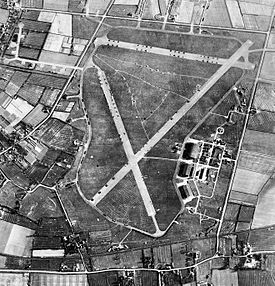RAF Goxhill
| RAF Goxhill USAAF Station 345 |
|
|---|---|
| Located Near Goxhill, Lincolnshire, England | |

RAF Aerial photograph of Goxhill airfield. taken on 29 April 1947. The runways are blocked with different types of equipment. Also, the control tower and technical site with two T2 hangars and a J-Type hangar is on the right.
|
|
|
RAF Goxhill shown within Lincolnshire (grid reference TA110210)
|
|
| Coordinates | 53°40′40″N 000°18′56″W / 53.67778°N 0.31556°W |
| Type | Royal Air Force station |
| Code | GX |
| Site information | |
| Owner | Air Ministry |
| Controlled by |
Royal Air Force United States Army Air Forces |
| Site history | |
| Built | 1940 |
| In use | 1940-1953 |
| Battles/wars |
European Theatre of World War II Air Offensive, Europe July 1942 - May 1945 |
| Garrison information | |
| Garrison |
RAF Bomber Command RAF Fighter Command Eighth Air Force Ninth Air Force |
Royal Air Force Goxhill or more simply RAF Goxhill is a former Royal Air Force station located east of Goxhill, on the south bank of the Humber estuary, opposite the city of Kingston upon Hull, in north Lincolnshire, England.
During the First World War a Royal Flying Corps landing ground existed near the Lincolnshire village of Goxhill. In 1940 the Air Ministry returned to survey the land once again for its suitability as an airfield.
Goxhill was originally used as a barrage balloon site to protect the port of Hull and the River Humber. In 1940, Goxhill was transferred to RAF Bomber Command and was planned and rebuilt as a bomber airfield. The base was equipped with three intersecting runways, the main runway at 1600 yards and two secondary runways of 1100 yards. Three hangars were built - two T-2's, one J-Type and four blisters and fifty aircraft hardstands. Temporary accommodation was provided for 1700+ personnel.
Its location, however, was too close to the air defences of Hull to be used for that purpose. Its first occupant was No. 1 Group that took up residence on 26 June 1941. The mission of No. 1 Group was towing practice targets with Westland Lysanders, its first operation beginning on 25 October.
In December 1941, RAF Fighter Command replaced the Bomber Command training unit with No. 12 Group, flying Supermarine Spitfires from No. 616 Squadron at RAF Kirton in Lindsey. Fighter Command operated the base until May 1942.
...
Wikipedia



